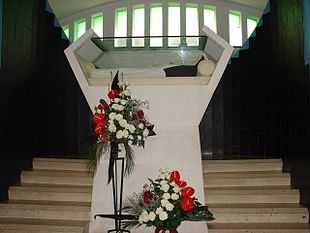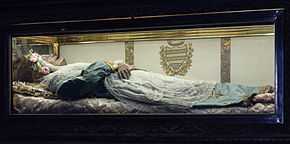Incorruptibility


Incorruptibility is a Roman Catholic and Eastern Orthodox belief that Divine intervention allows some human bodies (specifically saints and beati) to avoid the normal process of decomposition after death as a sign of their holiness. Bodies that undergo little or no decomposition, or delayed decomposition, are sometimes referred to as incorrupt or incorruptible.
Incorruptibility is thought to occur even in the presence of factors which normally hasten decomposition, as in the cases of Saint Catherine of Genoa, Saint Julie Billiart, or Saint Francis Xavier.[1]
Roman Catholicism
In Roman Catholicism, if a body is judged as incorruptible after death, this is generally seen as a sign that the individual is a saint. Not every saint, however, is expected to have an incorruptible corpse. Although incorruptibility is recognized as supernatural, it is no longer counted as a miracle in the recognition of a saint.[2]
Embalmed bodies were not recognized as incorruptibles. For example, although the body of Pope John XXIII remained in a remarkably intact state after its exhumation, Church officials remarked that the body had been embalmed[3] and additionally there was a lack of oxygen in his sealed triple coffin..
Incorruptibility is seen as distinct from the good preservation of a body, or from mummification. Incorruptible bodies are often said to have the odour of sanctity, exuding a sweet or floral, pleasant aroma.
Eastern Orthodox Church

To the Eastern Orthodox Church, incorruptibility continues to be an important element for the process of glorification. An important distinction is made between natural mummification and what is believed to be supernatural incorruptibility. There are a great number of eastern Orthodox saints whose bodies have been found to be incorrupt and are in much veneration among the faithful. These include:
- Anthony, John, and Eustathios
- Saint Alexander of Svir — the incorrupt relics of the saint were removed from the Svir Monastery by the Bolsheviks on December 20, 1918, after several unsuccessful attempts to confiscate them. Finally, the holy relics were sent to Petrograd's Military Medical Academy. There they remained for nearly eighty years. A second uncovering of St Alexander's relics took place in December 1997, before their return to the Svir Monastery.[4]
- Saint Dmitry of Rostov
- Saint Job of Pochayiv
- Saint John the Russian
- Saint Ioasaph of Belgorod — In 1918 the Bolsheviks removed Saint Ioasaph's relics from his shrine in the cathedral of the Holy Trinity at Belgorod, and for some seventy years, their whereabouts remained unknown. In 1927, the cathedral itself was demolished. In the late 1980s, the relics were discovered in Leningrad's Museum of Religion and Atheism, and on 16 September 1991, they were solemnly returned to the new Cathedral of the Transfiguration of Our Lord in Belgorod, in the presence of Patriarch Alexy II.[5]
- Saint Nectarios of Aegina
- Saint Parascheva of the Balkans
- Saint Seraphim of Sarov
- Saint Spyridon
- Dionysios of Zakynthos
- Gerasimus of Kefalonia
- Saint Zosima
- Saint Elizabeth
- Saint John Maximovitch of Shanghai and San Francisco
Instances
The saints and other Christian holy men and women whose bodies are said to be or to have been incorrupt have been catalogued in The Incorruptibles: A Study of the Incorruption of the Bodies of Various Catholic Saints and Beati, a 1977 book by Joan Carroll Cruz.[6] Incorruptibles include:
Romans
During marble excavations on the Appian Way in Spring 1485, workers found three marble coffins. In one, twelve feet underground, was the corpse of a young woman, said to have looked as if it had been buried that day, despite being about 1500 years old. The corpse attracted 20,000 plus crowds of spectators in the first few days, many of whom believed it to be of Tullia Ciceronis, whose epitaph was on one of the tombs.[7]
Saints


.jpg)








- Saint Agatha
- Saint Agnes of Montepulciano
- Saint Albert the Great
- Saint Alphege of Canterbury
- Saint Alphonse Mary of Liguori
- Saint Andrew Bobola
- Saint Angela Merici
- Saint Anthony Maria Zaccaria
- Saint Anthony of Padua
- Saint Antoninus
- Saint Benedict the Moor
- Saint Benezet
- Saint Bernadette Soubirous
- Saint Bernardine of Siena
- Saint Camillus de Lellis
- Saint Catherine Labouré
- Saint Catherine of Bologna
- Saint Catherine of Genoa
- Saint Catherine de Ricci
- Saint Catherine of Siena
- Saint Charbel Makhluf
- Saint Charles Borromeo
- Saint Cecilia
- Saint Clare of Montefalco
- Saint Coloman
- Saint Cuthbert
- Saint Diego of Alcalá
- Saint Dominic Savio
- Saint Edmund Rich of Canterbury
- Saint Edward the Confessor
- Saint Etheldreda
- Saint Eustochia Calafato
- Saint Frances of Rome
- Saint Francis of Paola
- Saint Francis de Sales
- Saint Francis Xavier
- Saint Frances Xavier Cabrini
- Saint George Preca
- Saint Germaine Cousin
- Saint Guthlac
- Saint Annibale Maria di Francia
- Saint Herculanus of Piegaro
- Saint Hugh of Lincoln
- Saint Idesbald
- Blessed Imelda Lambertini
- Saint Isidore the Farmer
- Saint Jane Frances de Chantal
- Saint John-Mary-Baptist Vianney (The Curé of Ars)
- Saint Jeanne de Lestonnac
- Saint Joaquina de Vedruna
- Saint John Bosco
- Saint John Neumann
- Saint John of God
- Saint John of the Cross
- Saint John Southworth
- Saint Josaphat
- Saint Julie Billiart
- Saint Louis Bertrand
- Saint Louise de Marillac
- Saint Luigi Orione
- Saint Lucy Filippini
- Saint Madeleine Sophie Barat
- Blessed Mafalda of Portugal[8]
- Saint Margaret of Cortona
- Venerable Mary of Jesus of Ágreda
- Venerable María de León Bello y Delgado
- Saint Maria Goretti
- Saint Martin de Porres
- Saint Mary Magdalene of Pazzi
- Blessed Mary of the Divine Heart[9]
- Saint Narcisa de Jesús
- Saint Nicholas of Tolentino
- Saint Pacifico of San Severino
- Saint Paula Frassinetti
- Saint Pascal Baylon
- Saint Peregrine Laziosi
- Saint Philip Neri
- Saint Philomena
- Saint Pierre Julien Eymard
- Saint Pio of Pietrelcina
- Saint Rafael Guízar Valencia
- Saint Rita of Cascia
- Saint Romuald
- Saint Rose of Lima
- Saint Rose of Viterbo
- Saint Rose Philippine Duchesne
- Saint Silvan
- Saint Sperandia
- Saint Stanislaus Kostka
- Saint Teresa of Ávila
- Saint Teresa Margaret of the Sacred Heart (Anna Maria Redi)
- Saint Therese of the Child Jesus
- Saint Ubald of Gubbio
- Saint Veronica Giuliani
- Saint Vincent de Paul
- Saint Vincent Pallotti
- Saint Waltheof
- Saint Werburgh
- Saint Withburga
- Saint Wunibald
- Saint Zita
Beati
See also
Footnotes
- ↑ Quigley, Christine (2005). The Corpse: A History. McFarland. p. 254. ISBN 0786424494.
- ↑ Archived at The Incorruptibles, The bodies of many medieval Catholic saints and martyrs have resisted decay for centuries— just the sort of mystery that begs for scientific inquiry, By Heather Pringle, Discover Vol. 22 No. 6 (June 2001)
- ↑ Sandri, Luigi (1 June 2001). "Blessed John XXIII's Remains Are Now On View At St Peter's". Christianity Today. Archived from the original on 11 February 2014. Retrieved 11 February 2014.
- ↑ The Marvelous Wonderworker of All Russia, Holy Venerable Alexander of Svir. St. Petersburg: Holy Trinity Monastery of St. Alexander of Svir, 2002.
- ↑ ST. IOSAF THE DIVINE PROTECTOR at angelfire.com
- ↑ Carroll Cruz, Joan (1977). The Incorruptibles: A Study of the Incorruption of the Bodies of Various Catholic Saints and Beati. Charlotte, NC: TAN Books. ISBN 0-89555-066-0.
- ↑ Translated letters about tombs on Appian Way, from Pagan and Christian Rome by Rodolfo Lanciani, 1896
- ↑ "Arouca, ainda mal conhecida". Aveiro e o seu Distrito. December 1967.
- ↑ Junta de Freguesia de Ermesinde - The Church of Sacred Heart of Jesus (Convent of Sisters of the Good Shepherd)
References
- The Incorruptibles: A Study of the Incorruption of the Bodies of Various Catholic Saints and Beati, by Joan Carroll Cruz, OCDS, TAN Books, June 1977. ISBN 0-89555-066-0.
- Christian Mummification: An Interpretive History of the Preservation of Saints, Martyrs and Others, by Ken Jeremiah, OCDS, McFarland & Co., Inc., 2012. ISBN 0786465190.